基于PLC的液位控制系统毕业设计论文
基于PLC水箱液位控制系统毕业设计

基于PLC水箱液位控制系统毕业设计水箱液位控制系统是一种常见的自动化控制系统,通过控制水位的高低来实现水箱中水的供应与排放。
该系统常用于水处理、供水系统、工业生产等领域。
本篇毕业设计将基于可编程逻辑控制器(PLC)来设计一个水箱液位控制系统。
PLC作为控制器,能够实现对水位的监测、控制和保护。
首先,本设计将使用传感器来监测水箱的液位。
液位传感器将放置在水箱内部,在不同的液位位置测量水的高度。
传感器将通过模拟信号将液位信息传输给PLC。
PLC将读取并处理传感器的信号,得到水箱的液位信息。
其次,PLC将根据液位信息来控制水泵的运行。
当水箱的液位低于一定的阈值时,PLC将启动水泵,从水源处将水注入到水箱中。
当液位达到一定的高度时,PLC将关闭水泵,停止水的注入。
通过控制水泵的启动和停止,系统可以实现自动补水,从而保持水箱的水位在一个恰当的范围内。
此外,本系统还将具备一定的保护功能。
当水箱液位过高或过低时,PLC将触发报警装置,以便及时采取措施解决问题。
同时,系统将设置相应的安全控制,以防止水泵出现过载或短路等故障。
为了实现PLC控制系统的功能,本设计将使用PLC编程软件进行程序的编写和调试。
程序将根据液位传感器的输入信号,进行逻辑判断和控制指令的输出。
同时,本设计将与水泵、报警装置等硬件进行连接,以实现实际的控制功能。
最后,本设计将进行系统的仿真和调试。
通过模拟真实的液位变化情况,测试系统的控制性能和稳定性。
在确保系统正常运行的前提下,对系统进行各项性能指标的测试和评估。
通过该毕业设计的实施,我将能够掌握PLC水箱液位控制系统的原理和设计方法,提升自己在自动化控制领域的实践能力和工程应用能力。
同时,通过该设计的完成,也能为工业生产中的水箱液位控制问题提供一种可行的解决方案。
PLC控制的水箱液位控制系统毕业论文
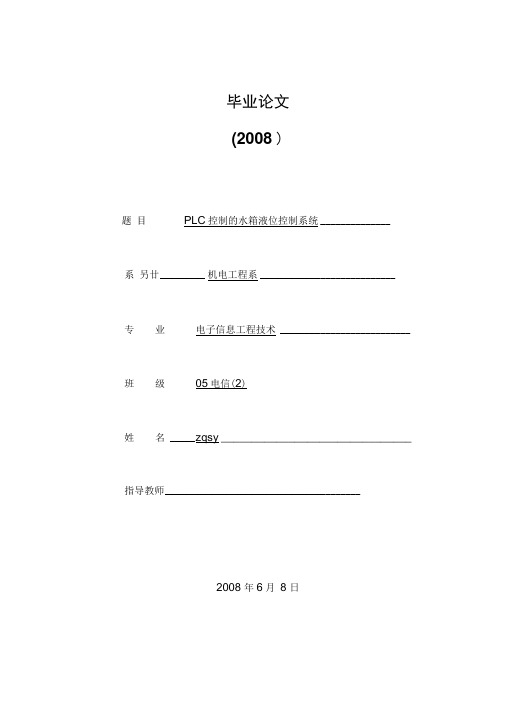
毕业论文(2008 )题目PLC控制的水箱液位控制系统______________系另廿_________ 机电工程系___________________________专业电子信息工程技术 __________________________ 班级05电信(2)姓名 _____ z qsy _______________________________ 指导教师_______________________________________2008 年6月8 日PLC控制的水箱液位控制系统摘要在人们生活以及工业生产等诸多领域经常涉及到液位和流量的控制问题, 例如居民生活用水的供应, 饮料、食品加工, 溶液过滤, 化工生产等多种行业的生产加工过程, 通常需要使用蓄液池, 蓄液池中的液位需要维持合适的高度, 既不能太满溢出造成浪费, 也不能过少而无法满足需求。
因此液面高度是工业控制过程中一个重要的参数,特别是在动态的状态下,采用适合的方法对液位进行检测、控制,能收到很好的效果。
可编程控制器(PLC )是计算机家族中的一员,是为工业控制应用而设计制造的,主要用来代替继电器实现逻辑控制。
PID控制(比例、积分和微分控制)是目前采用最多的控制方法。
本文主要是对一水箱液位控制系统的设计过程,涉及到液位的动态控制、控制系统的建模、PLC控制、PID算法、传感器和调节阀等一系列的知识。
作为单容水箱液位的控制系统,其模型为一阶惯性函数,控制方式采用了PID算法,控制核心为S7-200 系列的CPU222^及A/D、D/A转换模块,传感器为扩散硅式压力传感器,调节阀为电动调节阀。
选用以上的器件设备、控制方案和算法等,是为了能最大限度地满足系统对诸如控制精度、调节时间和超调量等控制品质的要求。
关键词PLC PID 液位控制目录第一章绪论 (4)第二章设计任务与要求 (6)2 . 1基本任务.............................................................................................. .62.2 基本要求 (6)2.3 给定条件 (6)2.4 主要性能指标 (6)2.5 扩展功能 (7)第三章总体论证 (7)3.1 总体方案的选择 (7)3.1.1 控制方法选择 (7)3.1.2 系统组成 (8)3.2 确定系统功能、性能指标 (8)第四章系统设计 (9)4.1 建模过程 (9)4. 2模型参数的确定 (10)4. 3 软、硬件功能划分 (12)4. 4系统功能划分、指标分配和框图构成 (12)(1)PLC系统 (13)(2)前向通道 (13)(3) .............................................................................................................................................. 后向通道 (13)第五章系统开发 (14)5.1 硬件开发——系统配臵 (14)5.1.1 PLC 系统一一CPU模/数转换模块、数/模转换模块 (14)5.1.2 前向通道——传感器 (15)5.1.3 后向通道——电动调节阀 (15)5.2 PID 操作指令 (16)5.2.1 PID 算法 (16)5.2.2 回路输入、输出转换及标准化 (19)5.2.3 控制方式 (20)5.2.4 回路表 (21)5.2.5 PID 指令 (22)5.2.6 PID 的编程步骤 (23)5.3 软件开发 (24)5.3.1 确定输入/ 输出关系,建立数学模型,寻找合适算法 (24)5.3.2 调节器参数整定 (25)5.3.3 程序流程图 (27)5.3.4 程序 (29)第六章连机调试 (33)总结 (35)致谢 (37)参考文献 (38)第一章绪论可编程控制器(简称PLC或PQ是一种新型的具有极高可靠性的通用工业自动化控制装臵,是一种数字运算操作的电子系统。
【《基于PLC的液位控制系统设计论文答辩稿》1100字】

基于PLC的液位控制系统设计论文答辩稿本文以西门子S7-300中型可编程控制器为核心,以MCGS组态软件为上位机,然后设计一个PLC的水箱液位控制系统。
采用液位传感器检测储水箱和水箱液位,使用流量传感器检测入水流量,通过水泵供水,使用调节阀调节入水流量。
该系统使用液位传感器实时检测水箱液位,由PLC进行处理,进行PID调节,PID输出,用于PID 控制环路的设置,并对流量进行PID调整,流量PID调节输出控制电调节阀开度,实现液位控制。
本文总体设计中分析了液位控制系统控制原理,由水泵电机M1和调节阀V1为水箱供水。
在储水罐内进行储水时,打开电路上的手动阀门。
关闭水管上的调压阀和电磁阀门,F1流量计显示出管道内压力值;当水压达到设定值后,开始工作。
当测得的水压值过低时,报警灯闪烁。
关闭开关。
启动系统启动M1水泵电机对水箱水位进行PID 控制及PID流量控制,调水阀自动开启并对LT2水箱水位进行调控。
并给出了液位控制系统串级控制流程。
在硬件设计当中,主要包括:PLC选择、调节阀的选择、液位测量变送仪表的选择、主电路设计、控制电路设计、PLC输入和输出分配以及PLC输入和输出接线图。
本文选用S7-300 PLC作为控制核心,并经过对比分析控制阀开关方式、流量特性、结构形式,最后选用了ZAJP精小型电动单座调节阀对系统流量进行控制。
同时,针对液位测量变送仪表,分析了差压式液位变送器的工作原理及选型方式,最后确定采用DP系列LT型智能液位变送器对系统液位进行监控,并设计了主电路、控制电路,最后画出了PLC输入和输出接线图。
在软件设计当中,对其控制流程展开分析,并画出了控制流程图以及梯形图,并搭建上位机,进行组态模拟运行,检测系统可行性。
最后通过HMI设计,搭建出组态监控画面,使用模拟自动化系统和WINCC来执行联合模拟测试,完成了液位控制系统设计。
本文设计的液位控制系统,其中水箱液位为主要控制参数,流量为二级控制参数,调节阀开度为控制参数,MCGS PID软件装置为控制器,形成采用MCGS集成PID软件设备,通过液位PID控制和流量PID控制实现水箱液位自动控制。
毕业设计-基于plc的液位控制系统

因此工业生产中离不开PLC,是没有争议的。目前中国PLC市场本土品牌几乎没有,最受国人青睐的品牌有三菱、欧姆龙、西门子、罗克韦尔、施耐德、GE-Fanuc等国际知名公司。大中型PLC欧美品牌市场份额最大,小型PLC日本品牌也实力雄厚,另外,中国台湾与韩国也有一小部分市场。
网络化、微型化、电脑化和开放性是PLC未来发展的主要趋势.在PLC自动化的最初时期,其体积庞大而且价格不菲。但近些年以来,微型PLC(小于32 I/O口)已经问世,价格也只有几百美元.现如今我们使用PLC的同时还要必须使用单独的监控组态软件作为辅助工具,PLC以后的发展趋势就是在自身的系统里自带有与自身硬件相匹配的监控组态软件,这样会更受到广大用户的喜欢,也更符合市场的需求,也是新的商机,更是一种趋势。
毕业设计基于plc和组态软件的水位控制系统本科学位论文
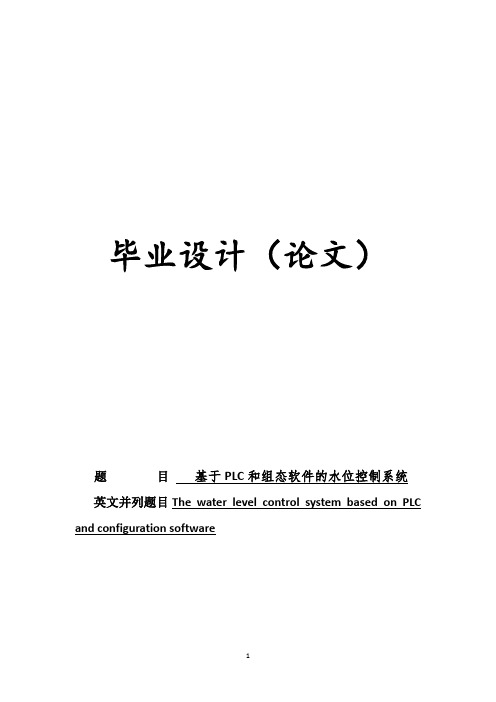
毕业设计(论文)题目基于PLC和组态软件的水位控制系统英文并列题目The water level control system based on PLC and configuration software毕业设计(论文)开题报告学生姓名学号班级电气21331所属院系专业控制技术学院电气自动化指导教师职称讲师所在部门控制技术学院毕业设计(论文)题目基于PLC和组态软件的水位控制系统题目类型工程设计(项目)√论文类□作品设计类□其他□随着现代社会生产的发展和技术的进步,现代工业自动化水平的日益提高,电子技术的飞速发展,在继电器控制系统的基础上产生了一种新型的工业控制装置——可编程控制器。
工业液体的液位控制系统是工业生产中比较重要的控制应用之一。
随着微处理器、自动化仪表和数字通信网络的飞速发展,控制手段也越来越丰富。
在现代工业生产中,小型PLC的高可靠性和电动阀快速准确等特点在工业生产中有着广阔的应用前景。
随着科技的发展和现实暴露的一些问题,以便能更快更方便的完成一些任务,在生产过程中,经常需要对液位的来进行控制,而对于这控制,因PLC的功能特点及组态软件拥有能够完成现场数据采集、实时和历史数据处理、报警和安全机制、流程控制、动画显示、趋势曲线和报表输出以及企业监控网络等功能。
所以非常适合来控制水位的高低。
本次毕业设计的课题是基于PLC与组态的水位控制系统。
在设计中,主要是对PLC 控制程序的设计和组态的画面设计。
二、课题综述(课题研究,主要研究的内容,要解决的问题,预期目标,研究步骤、方法及措施等)第一课题研究基于PLC和组态软件的水位控制系统第二主要研究的内容1、如何构建系统的组态环境2、如何构建水塔水位控制装置3、如何将组态软件与PLC连接4、选择并熟悉所采用的三菱PLC的FX2N系列的主要功能第三要解决的问题1、运用组态软件模拟整个三菱PLC控制系统的运行,通过触摸屏对水塔水箱水位的控制2、元器件型号的选型第四预期目标1、选择合适的PLC,能够以其为核心设计出整个控制系统2、通过水塔水位控制装置构建组态软件模拟运行环境3、将组态软件与PLC相连并连接到触摸屏上4、通过触摸屏实现对水塔水箱水位的控制第五研究步骤、方法及措施通过对水塔位控制装置的了解分析,先构造系统框图,在配上相应的组态软件的模拟图以及PLC程序图。
基于PLC的液位控制系统设计_毕业设计论文
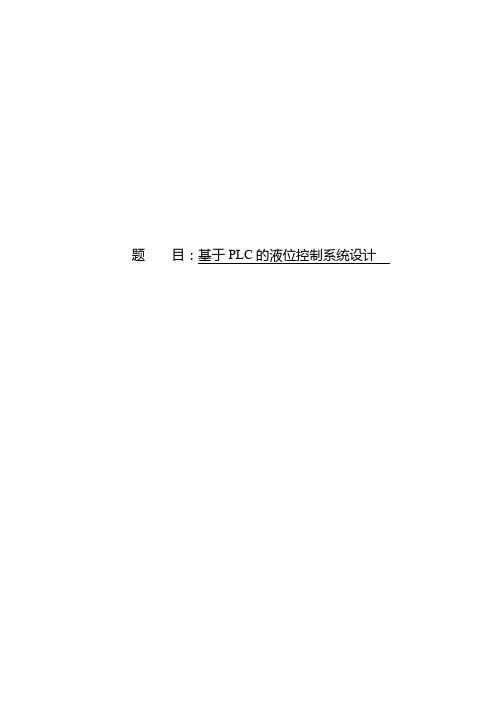
题目:基于PLC的液位控制系统设计毕业论文(设计)作者声明本人郑重声明:所呈交的毕业论文是本人在导师的指导下独立进行研究所取得的研究成果。
除了文中特别加以标注引用的内容外,本论文不包含任何其他个人或集体已经发表或撰写的成果作品。
本人完全了解有关保障、使用毕业论文的规定,同意学校保留并向有关毕业论文管理机构送交论文的复印件和电子版。
同意省级优秀毕业论文评选机构将本毕业论文通过影印、缩印、扫描等方式进行保存、摘编或汇编;同意本论文被编入有关数据库进行检索和查阅。
本毕业论文内容不涉及国家机密。
论文题目:作者单位:作者签名:年月日目录摘要 (1)引言 (1)1.研究现状分析 (2)1.1题研究背景、意义和目的 (2)1.2液位控制系统的发展状况 (3)1.3课题研究的主要内容 (3)2.控制方案设计 (4)2.1系统设计 (4)2.2单容水箱对象特性 (5)3.硬件配置 (8)3.1控制单元 (8)3.2检测单元 (8)3.3执行单元 (9)4.软件设计 (9)4.1STEP 7-Micro/WIN编程软件简介 (9)4.2参数设定及I/O分配 (9)5.程序编程和系统仿真 (12)5.1程序设计 (12)5.2程序仿真和分析 (12)6.结论 (16)参考文献 (16)附录 (18)致谢 (21)基于PLC的液位控制系统设计摘要:针对人工控制液位的准度低、速度慢、灵敏度低等一系列问题。
本文提出基于PLC的液位控制系统,系统通过将液位传感器检测到的电信号送入PLC中,经过A/D变换成数字信号,送入数字PID调节器中,经PID算法后将控制量经过D/A转换成水泵电机转速相对应的电信号送入水泵电机来控制水泵转速,最终达到控制液位的目的。
通过仿真和分析结果表明本文所设计系统能够正常运行并且达到了设计的目的,能够准确、快速地控制液位,克服了传统液位控制系统的很多弊端。
关键词:S7-200;PLC;PID控制;液位控制The System Design for Level Controling Based on PLC Abstract: The purpose of this design is solving the controling of liquid level of low accuracy, slow speed, sow sensitivity, a series of problems. The system designed in this paper based on PLC to control the liquid level, after A / D converted into digital signals into the digital PID controller, PID algorithm will control the amount of after D / A conversion into electrical signal corresponding to the pump motor speed into the pump motor to control the pump speed, and ultimately achieve the purpose of the control level. The simulation and analysis results shows that the designed system can run normally and it have achieved the goal of this design, it can control liquid level accuracy and high speed, it overcomes many disadvantages of traditional liquid level controling.Key Words: S7-200 ; PLC ; PID Control ; Level Control引言在自动化控制的工业生产过程中,一个很重要的控制参数就是液位。
基于PLC的液位控制系统研究毕业设计(论文)

毕业设计论文基于PLC的液位控制系统研究摘要本文设计了一种基于PLC的储罐液位控制系统。
它以一台S7-200系列的CPU224和一个模拟量扩展模块EM235进行液位检测和电动阀门开度调节。
系统主要实现的功能是恒液位PID控制和高低限报警。
本文的主要研究内容:控制系统方案的选择,系统硬件配置,PID算法介绍,系统建模及仿真和PLC编程实现。
本设计用PLC编程实现对储罐液位的控制,具有接线简单、编程容易,易于修改、维护方便等优点。
关键字:储罐;液位控制;仿真;PLCAbstractThis article is designed based on PLC, tank level control system. It takes a series s7-200 CPU224 and an analog quantities of EM235 expansion module to level detection and electric valve opening regulation.System main function is to achieve constant low level PID control and limiting alarm.The main contents of this paper: the choice of the control system plan, system hardware configuration, PID algorithm introduced, system modeling and simulation, and PLC programming. PLC programming with the design of the tank level control have the advantage of simple wiring, easy programming, easy to modify, easy maintenance and so on.Key word: tank ; level ;control ;simulation ;plc目录摘要 (I)ABSTRACT ........................................................... I I 1 绪论. (1)1.1盐酸储罐恒液位控制任务 (1)1.2本文研究的意义 (2)1.3本文研究的主要内容 (2)2 控制系统方案设计 (3)2.1储罐液位控制的发展及现状 (3)2.2系统功能分析 (3)2.3系统方案设计 (4)3 系统硬件配置 (5)3.1电动控制阀的选择 (5)3.1.1 控制阀的选择原则 (5)3.1.2 ZAJP 精小型电动单座调节阀性能和技术参数介绍 (10)3.2液位测量变送仪表的选择 (13)3.2.1 液位仪表的现状及发展趋势 (13)3.2.2 差压变送器的测量原理 (13)3.2.3 差压式液位变送器的选型原则 (14)3.2.4 DP系列LT型智能液位变送器产品介绍 (15)3.3PLC机型选择 (16)3.3.1 PLC历史及发展现状 (16)3.3.2 PLC机型的选择 (18)3.3.3 S7-200系列CPU224和EM235介绍 (20)4 PID算法原理及指令介绍 (21)4.1PID算法介绍 (22)4.2PID回路指令 (24)5 系统建模及仿真 (28)5.1系统建模 (28)5.2系统仿真 (30)5.2,1 MATLAB语言中Simulink交互式仿真环境简介 (30)5.2.2 系统仿真 (31)第6章系统编程实现 (33)6.1硬件设计 (33)6.1.1 绘制控制接线示意图 (33)6,1.2 I/O资源分配 (33)6.2软件设计 (34)6.2.1 STEP 7 Micro/Win V4.0 SP6编程软件介绍 (34)6.2.2 恒液位PID控制系统的PLC控制流程 (35)6.2.3 编写控制程序 (36)6.2.4 程序清单 (39)结束语 (40)参考文献 (41)致谢 (42)1 绪论1.1 盐酸储罐恒液位控制任务如图1.1所示为某化工厂稀盐酸储罐,该罐为钢衬聚四氟乙烯储罐,罐体高6米,容量为50立方米,重500千克。
基于PLC的液位控制系统设计 - 副本

摘要本次毕业设计的课题是基于PLC的液位控制系统的设计。
在设计中,笔者主要负责的是控制算法的设计,因此在论文中设计用到的PID算法提到得较多。
本文的主要内容包括:水箱的特性确定与实验曲线分析,S7-300可编程控制器的硬件掌握,PID参数的整定及各个参数的控制性能的比较,应用PID控制算法所得到的实验曲线分析,整个系统各个部分的介绍和应用PLC语句编程来控制水箱水位。
关键词:S7-300西门子PLC、控制对象特性、PID控制算法、扩充临界比例法、压力变送器、电动调节阀、PID指令。
AbstractThis graduation project topic is based on the PLC fluid position control system design. In the design, I am control the algorithm which the author primary cognizance the design, therefore designs in the paper with to the PID algorithm mentions many.The this article main content includes: water tank characteristic determination and experimental curve analysis,the S7-300 programmable controller hardware grasps,PID parameter installation and each parameter control performance comparison,experimental curve analysis obtains which using the PID control algorithm and overall system each part of introduction and programs using the PLC sentence controls the water tank water level.Key words: SIMATIC S7-300 PLC, the controlled member characteristic, the PID control algorithm, the expansion critical ratio method, the pressure change delivering, the electrically operated regulating valve.目录摘要 (1)ABSTRACT (1)第1章绪论 (1)1.1PLC的产生、定义及现状 (1)1.2过程工业控制算法的应用现状 (2)1.3PID控制的历史和发展现状 (3)1.4论文的研究内容 (5)第2章S7-300中小型PLC和控制对象介绍 (6)2.1西门子PLC控制系统 (6)2.1.1 CPU模块 (7)2.1.2 模拟量输入模块 (8)2.1.3 模拟量输出模块 (9)2.1.4 电源模块 (10)2.2控制对象特性 (11)2.2.1 一阶单容上水箱特性 (11)2.2.2 二阶双容下水箱对象特性 (14)第3章PID控制算法介绍 (18)3.1PID控制算法 (18)3.2PID调节的各个环节及其调节过程 (20)3.2.1 比例控制与其调节过程 (20)3.2.2 比例积分调节 (21)3.2.3 比例积分微分调节 (22)3.3串级控制 (22)3.4扩充临界比例法 (24)3.5在PLC中的PID控制的编程 (25)3.5.1 回路的输入输出变量的转换和标准化 (26)3.5.2 变量的范围 (28)3.5.3 控制方式与出错处理 (28)第4章控制方案设计 (31)4.1系统设计 (31)4.1.1 上水箱液位的自动调节 (31)4.1.2上水箱下水箱液位串级控制系统 (32)4.2硬件设计 (33)4.2.1 检测单元 (33)4.2.2 执行单元 (34)4.2.3 控制单元 (35)4.3软件设计 (36)第5章实验情况介绍 (39)5.1上水箱液位比例调节 (39)5.2上水箱液位比例积分调节 (40)5.3上水箱液位比例积分微分调节 (41)第6章结论 (43)参考文献 (44)致谢 (45)第1章绪论1.1 PLC的产生、定义及现状可编程控制器出现前,继电器控制在工业控制领域占据主导地位。
基于PLC的液位控制系统设计
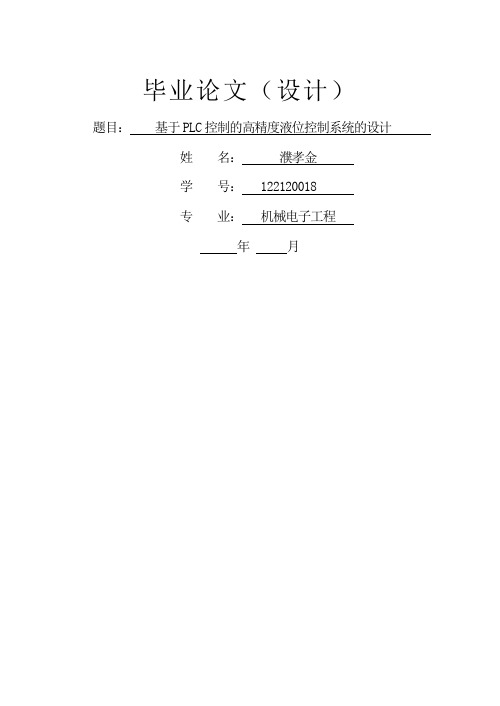
毕业论文(设计)题目:基于PLC控制的高精度液位控制系统的设计*名:***学号: *********专业:机械电子工程年月摘要在工农业生产过程中,经常需要对水位进行测量与控制,而日常生活中应用到的水位控制也相当广泛。
在以往水塔液位控制系统中,常规继电器的频繁操作容易导致机械磨损,不方便更新和维护,不能满足人们的实际需求;另外,随着人口的递增和生活条件的提高,人们用水的需求量也日益增加。
为了提高液位控制系统的质量和效率,节约能源,本次模拟水塔液位控制系统的装置考虑结合可编程逻辑控制器,继电器和传感器等技术,实现液位控制系统的自动控制。
本设计使用西门子S7-300 PLC可编程控制器作为液位控制系统的核心,配合硬件与软件实现液位控制池液位动态平衡,过高、过低水位报警等功能。
主要的实验方法是在水箱上安装一个自动水位测量装置,通过水位变送器检测水箱实际液位并将该液位反馈到PLC控制器,经A/D转换后,所得数据与PLC内部设定数据进行比较,控制器处理数据并发送相应指令改变电机的转速从而控制抽水速率,改变进水量,使水位稳定地保持在设定值附近。
此外,通过液位标定计算出控制器输出PIW数值与实际水位的关系,就可以在触摸屏上直观显示实时水位情况。
实验结果表明本设计能较好地完成自动液位控制的功能。
关键词:水塔液位控制,水位控制,继电器,PLCAbstractIn the course of routine industrial and agricultural production we the need to measure the water level and control it. Furthermore everyday level control applications are quite extensive , such as hydropower , water towers and other water control . According to the water supply system in the past, frequent operation towers will produce mechanical wear of conventional relay convenient maintenance and updates, that means it can not meet the actual needs of the people, and with Gradual growth of population and living conditions, the demand for water is also increasing .In order to improve the quality of the water supply system, energy conservation, so I considered use a programmable logic controller, relay and sensor technology, with hardware and software to achieve low water level alarm, warning switch between work and procedures manual / automatic to design practical level control tower scheme. I completed the set up of this simulation using the tank water tower , based on Siemens S7-300 PLC programmable controller tank water level control system as the core .I completed a water tank to complete the performance capability aiming at doing a needs analysis. The main experimental method used is to install an automatic water level measuring device on the tank. The level sensor detecting the water tank to measure the actual water leveland the control module to send information to the PLC, via A / D conversion, the data obtained is compared with the set level, the controller processes the data and sends the appropriate commands to control the motor speed change pumping rate, the water level maintained in the proper position. Than Touch screen completes the level display, fault alarm information display, real-time and historical curve curves show. If the water level is lower or higher than the set value, the hazard warning signal will be issued In this paper , PLC automatic water supply system based on good execution process level control .Keywords: tower water; water level control; relays; PLC目录第一章绪论 (1)§ 1.1研究背景 (1)§ 1.2 PLC的产生与发展 (1)1.2.1 PLC的产生 (1)1.2.2 PLC技术的发展 (2)§ 1.3设计任务 (3)第二章液位控制装置硬件设计 (4)§ 2.1 自动液位控制系统应用简介 (4)§ 2.2液位控制装置硬件组成 (4)§ 2.3 PLC的基本结构.............................. 错误!未定义书签。
毕业设计(论文)-基于PLC和组态技术的水箱液位串级控制系统设计
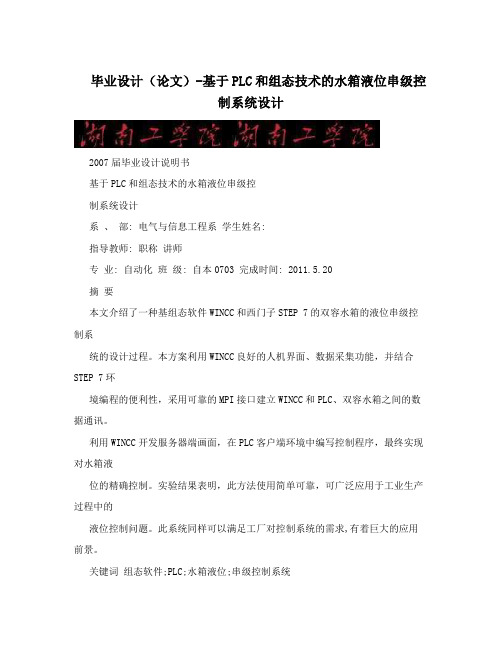
毕业设计(论文)-基于PLC和组态技术的水箱液位串级控制系统设计2007届毕业设计说明书基于PLC和组态技术的水箱液位串级控制系统设计系、部: 电气与信息工程系学生姓名:指导教师: 职称讲师专业: 自动化班级: 自本0703 完成时间: 2011.5.20摘要本文介绍了一种基组态软件WINCC和西门子STEP 7的双容水箱的液位串级控制系统的设计过程。
本方案利用WINCC良好的人机界面、数据采集功能,并结合STEP 7环境编程的便利性,采用可靠的MPI接口建立WINCC和PLC、双容水箱之间的数据通讯。
利用WINCC开发服务器端画面,在PLC客户端环境中编写控制程序,最终实现对水箱液位的精确控制。
实验结果表明,此方法使用简单可靠,可广泛应用于工业生产过程中的液位控制问题。
此系统同样可以满足工厂对控制系统的需求,有着巨大的应用前景。
关键词组态软件;PLC;水箱液位;串级控制系统ABSTRACTThis article describes the configuration software based on the WINCC and Siemens STEP7 tank liquid level PID control experimental platform design process. The program used WINCC good man-machine interface, data acquisition capabilities, combined with the convenience of STEP 7 programming environment, using MPI interface to establish a reliable configuration software WINCC and the PLC, double data communication between the tank. Development of server-side with Configuration software WINCC, the client environment in the PLC control program written, and ultimately the precise control of the water tank level. Experimental results show that this method is simple and reliable, can be widely used in industrial production process liquid level control problem. The system also meets the needs of the factory on the control system has a great prospect.Key words Configuration software;PLC;water tank;Cascade Control System1目录1 绪论 (3)1.1 过程控制系统的发展概况及趋势 (3)1.2 PLC的发展概况及趋势 (4)1.3 组态软件的发展概况及趋势 (4)1.4 各章节主要内容..............................................................................5 2 水箱液位串级控制系统总体设计 (6)2.1 现场系统组成 (6)2.2 双容水箱控制系统结构 (8)2.3 串级控制系统 (10)2.4 控制规律....................................................................................11 3 控制系统设计 (14)3.1 S7-400PLC概述 (14)3.2 STEP 7软件的介绍 (14)3.3 硬件组态 (15)3.4 创建数据块DB41 (20)3.5 创建功能块FB41 (20)3.6 创建组织块OB35 (21)3.7 通信设置…………………………………………………………………………223.8 程序下载....................................................................................23 4 监控程序的设计 (24)4.1 WINCC简介 (24)4.2 监控界面的设计...........................................................................25 5 水箱液位串级控制系统调试 (32)5.1 FCS系统实物调试 (32)5.2 PLCSIM离线仿真调试.....................................................................33 结束语 (35)参考文献.............................................................................................36 致谢 (37)21 绪论液位控制问题是工业生产过程中的一类常见问题,例如在饮料、食品加工,溶液过建,化工生产等多种行业的生产加工过程都需要对液位进行适当的控制。
基于PLC水箱液位控制系统毕业设计

毕业设计(论文)课题名称:关于PLC的液位控制系统指导教师:系别:电子信息系专业:机电一体化班级:姓名:摘要本次毕业设计的课题是基于PLC的液位控制系统的设计。
在设计中,笔者主要负责的是数学模型的建立和控制算法的设计,因此在论文中设计用到的PID算法提到得较多,PLC方面的知识较少。
本文的主要内容包括:PLC的产生和定义、过程控制的发展、水箱的特性确定与实验曲线分析, FX2系列可编程控制器的硬件掌握,PID参数的整定及各个参数的控制性能的比较,应用PID控制算法所得到的实验曲线分析,整个系统各个部分的介绍和讲解PLC的过程控制指令PID指令来控制水箱水位。
关键词:FX2系列PLC,控制对象特性,PID控制算法,扩充临界比例法,PID指令,实验。
目录摘要 (II)目录 (III)1 绪论 (1)1.1 PLC的产生、定义及现状 (1)1.1.1PLC的产生、定义 (1)1.1.2PLC的发展现状 (1)1.2过程控制的发展 (2)1.3本文研究的目的、主要内容 (3)1.3.1本文研究的目的、意义 (3)1.3.2本文研究的主要内容 (3)2 FX2系列PLC和控制对象介绍 (4)2.1 三菱PLC控制系统 (4)2.1.1 CPU模块 (4)2.1.2 I/O模块 (5)2.1.3电源模块 (5)2.2 过程建模 (5)2.2.1 一阶单容上水箱对象特性 (5)2.2.2 二阶双容下水箱对象特性 (10)3 PID调节及串级控制系统 (14)3.1 PID调节的各个环节及其调节过程 (14)3.1.1比例控制及其调节过程 (15)3.1.2比例积分调节 (15)3.1.3比例积分微分调节 (16)3.2 串级控制 (17)3.2.1串级控制系统的结构 (17)3.2.2串级控制系统的特点 (18)3.2.3串级控制系统的设计 (18)3.3 扩充临界比例度法 (20)3.4 三菱FX2系列PLC中PID指令的使用 (21)3.5在PLC中的PID控制的编程 (22)3.5.1回路的输入输出变量的转换和标准化 (22)3.6变量的范围 (24)4 控制方案设计 (26)4.1 系统设计 (26)4.1.1上水箱液位的自动调节 (26)4.1.2上水箱下水箱液位串级控制系统 (28)4.2 硬件设计 (28)4.2.1检测单元 (28)4.2.3控制单元 (29)4.3软件设计 (30)5 运行 (31)5.1 上水箱液位比例调节 (31)5.2 上水箱液位比例积分调节 (31)5.3 上水箱液位比例积分微分调节 (31)6 结论 (33)致谢 (33)参考文献 (33)1 绪论1.1 PLC的产生、定义及现状1.1.1PLC的产生、定义一、可编程控制器的产生20世纪60年代,在世界技术改造的冲击下,要求寻找一种比继电器更可靠、功能更齐全、响应速度更快的新型工业控制器。
基于PLC的液位控制系统毕业设计论文
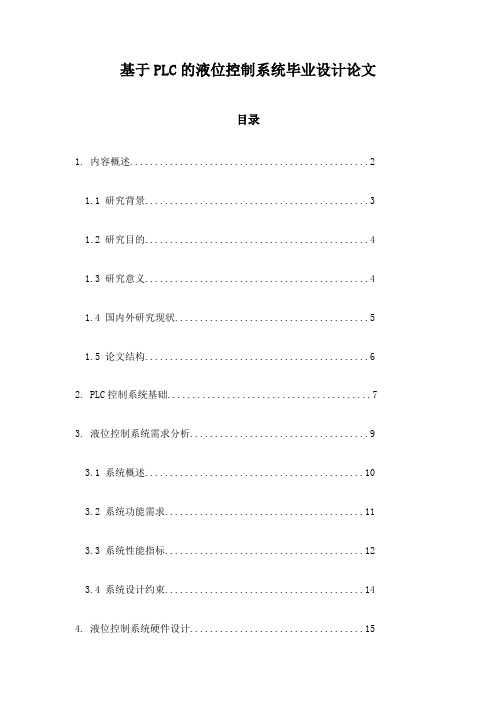
基于PLC的液位控制系统毕业设计论文目录1. 内容概述 (2)1.1 研究背景 (3)1.2 研究目的 (4)1.3 研究意义 (4)1.4 国内外研究现状 (5)1.5 论文结构 (6)2. PLC控制系统基础 (7)3. 液位控制系统需求分析 (9)3.1 系统概述 (10)3.2 系统功能需求 (11)3.3 系统性能指标 (12)3.4 系统设计约束 (14)4. 液位控制系统硬件设计 (15)4.1 硬件组成及连接方式 (17)4.2 传感器选型及安装方式 (18)4.3 执行器选型及安装方式 (20)4.4 PLC选型及安装方式 (22)4.5 电气接线及调试 (24)5. 液位控制系统软件设计 (24)5.1 软件架构设计 (26)5.2 控制算法设计 (28)5.3 PLC程序编写 (29)5.4 仿真与调试 (31)6. 系统集成与测试 (33)6.1 系统集成方案设计 (34)6.2 系统测试与验证 (36)6.3 结果分析与讨论 (37)7. 结论与展望 (38)7.1 研究成果总结 (39)7.2 进一步研究方向建议 (40)1. 内容概述本毕业设计论文旨在深入研究和探讨基于可编程逻辑控制器(PLC)的液位控制系统设计与实现。
通过系统化的设计流程,结合理论分析与实际应用,全面阐述PLC在液位控制中的关键作用及其优化策略。
随着工业自动化技术的不断发展,液位控制作为工业生产过程中的重要环节,其精确性和稳定性对于保障产品质量和生产效率具有至关重要的作用。
PLC作为一种高效、可靠的工业控制设备,在液位控制领域得到了广泛应用。
本研究将围绕基于PLC的液位控制系统展开深入研究。
PLC具有强大的数据处理能力,能够实时监控液位变化,并根据预设的控制算法输出相应的控制信号。
PLC的可靠性高、抗干扰能力强,能够在恶劣的工业环境下稳定运行。
PLC还具有易于扩展和维护的特点,便于用户根据实际需求进行系统升级和改造。
自动化专业论文 基于西门子PLC的双容水箱液位控制系统设计

基于西门子PLC的双容水箱液位控制系统设计摘要液位控制系统是PLC在工业控制中的重要应用,本文介绍了基于西门子PLC-200的双容水箱液位控制系统,对双容水箱进行了系统建模和控制方案设计,然后通过MATLAB工具对PID控制算法进行了仿振,验证了PID调节器对于液位的控制作用。
并利用现场相关的硬件设施配合组态王6.5.5软件进行上位机监控系统的开发,完成了对现场数据的采集、流程图画面制作、实时曲线显示等功能,以实现对液位的实时监测和控制。
仿真结果表示,该系统可有效解决双容水箱液位控制中存在的容量滞后问题。
最后,对全文所做的工作进行了总结,分析了不足之处,并对液位控制的前景进行了展望。
关键词:西门子PLC;双容水箱;组态王;PID控制AbstractLiquid level control system is an important application of PLC in industrial control, this paper introduces the double let water tank level control system which bases on Siemens PLC-200, it do the work of the system modeling and control designing for double-tank system. Then,PID control algorithm is simulated through MATLAB tool, to verify the effectiveness of the PID controller for level control function. And by using the related hardware facilities together with kingview 6.5.5 software for the development of PC monitoring and controlling system, it completes the function of collecting the flow chart, manufacturing field data, and showing real-time curve, etc, in order to realize the real-time monitoring and control of the liquid level. The results of simulation show that the system can effectively solve the problem of existing V olume lag in the double let water tank level control. In the end,it summarizes the whole work of this paper, analyzs the deficiency, and the prospect of liquid level control is discussed.Keywords:Siemens; double-tank system; kingview; PID control;摘要 (I)Abstract (II)第1章绪论 (6)1.1液位控制研究的背景及其意义 (6)1.2液位控制的研究现状 (8)1.3论文主要工作 (9)第2章系统建模和方案论证 (10)2.1系统建模 (10)2.1.1双容水箱水位的动态特性 (10)2.1.2双容水箱的飞升曲线 (11)2.2双容水箱串级调节系统 (13)2.3系统设计方案 (13)第三章 PID控制算法 (15)3.1PID调节器简介 (15)3.2PID控制原理 (15)3.3MATLAB仿真结果 (16)第四章系统硬件设计 (17)4.1液位控制系统的结构 (17)4.2液位控制系统的选型 (20)第五章基于组态王的双容水箱监控软件开发 (22)5.1组态王软件简介 (22)5.2双容水箱液位控制系统工程的组态设计 (22)结语 (31)参考文献 (32)致谢 (33)附录 (34)PLC程序梯形图 (34)主程序 (34)PID初始化 (36)第1章绪论1.1液位控制研究的背景及其意义当今工业生产发展很快,人们希望进一步提高生产过程自动化控制水平和获得更好的工业产品质量。
安徽工程大学毕业答辩毕业论文基于plc和组态软件的液位控制系统设计

1. 概 述
目的与意义
液位控制由于其应用极其普遍,种类繁多, 其中不乏一些大型的复杂系统。它主要有以下 几个特点:1、时滞性很大,2、时变性,3、非 线性。 这几个特点,都严重影响PID控制的效果,在 实际生产中而随着生产线的更新及生产过程控 制要求的提高,要求液位控制系统有高的控制 精度,即准确稳定的液位,一般的得自动化控 制方式已不能满足工业生产控制的要求,为了 使系统具有直观准确的显示功能,我们采用 PLC和组态软件对液位进行控制。
PLC 外部设备连接
I0.0
I0.1
液位变 送器
S7-200 PLC CPU226
扩展AI模块 EM235
扩展AO模块 EM232
高液位 报警 I0.2
低液位 报警 I0.3
变频器 MM420
10
3. 系统硬软件设计
变量分配表
11
3. 系统硬软件设计
M C G S 组 态 用 户 界 面
12
4. 结 论
和
变
频
器
的 链 接 线 路
SB3
SB2
KA K1 A K2 A 3KA 4启
动
停止 SB1
手 动
KA
KA
KA HL
2
3
4
~220 V 24V
NL
1L
I0.0
Q0.
I0.1
Q0 0.
I0.2
Q1 0.
I0.3
Q2 0.
I0.4
23L
I0.5
Q0.
I0.6
Q4 0.
I0.7
Q5 0.
1L+
Q650.
I1.0
14
目录
基于plc的液体混合系统的控制毕业设计

基于plc的液体混合系统的控制毕业设计一、研究背景随着工业自动化的不断发展,PLC(可编程逻辑控制器)作为一种重要的控制器件,被广泛应用于各个领域。
其中,在液体混合系统中,PLC 也扮演着重要的角色。
液体混合系统是指将两种或多种不同的液体按照一定比例混合,以达到特定的化学反应或工艺要求。
因此,在液体混合系统中,PLC可以通过对各个部件进行精准控制,实现液体流量、温度等参数的精确调节和监控。
二、研究目标本毕业设计旨在基于PLC实现液体混合系统的控制,并能够实时监测和记录各项参数变化。
具体目标如下:1. 设计并构建一个完整的液体混合系统。
2. 选用适当的传感器和执行器,并设计相应的电路。
3. 编写PLC程序,实现对液体流量、温度等参数进行精确调节和监测。
4. 实时记录各项参数变化,并能够生成相应报表。
三、研究内容1. 液体混合系统硬件设计(1)液体混合系统的结构设计液体混合系统的结构设计需要考虑到液体的流动性和混合效果。
一般来说,液体混合系统包括进料系统、混合系统和出料系统三个部分。
其中,进料系统包括进料管道、泵、阀门等部件;混合系统包括搅拌器、加热器等部件;出料系统包括出料管道、阀门等部件。
(2)传感器和执行器的选用在液体混合系统中,需要选用适当的传感器和执行器来实现对各项参数进行监测和调节。
例如,可以选用流量传感器、温度传感器等来监测液体流量和温度;可以选用电磁阀、气动阀等执行器来控制进料管道和出料管道的开关。
(3)电路设计根据所选用的传感器和执行器,需要设计相应的电路。
例如,可以采用模拟量输入模块来接收流量传感器输出的模拟信号;可以采用数字量输出模块来控制电磁阀或气动阀。
2. PLC程序设计根据硬件设计完成后,需要编写PLC程序实现对液体混合系统进行控制。
PLC程序需要实现以下功能:(1)监测液体流量和温度,并实时调节。
(2)实现进料管道和出料管道的开关控制。
(3)实现搅拌器的开关控制。
(4)实时记录各项参数变化,并能够生成相应报表。
基于PLC的液位控制系统毕业设计论文

基于PLC的液位控制系统毕业设计论文随着工业自动化水平的不断提高,液位控制系统在工业领域中得到了
广泛的应用。
液位控制系统是通过感知到液体的高度来实现对液位的控制,常用于储罐、水塔等场所,以确保液位在安全范围内。
本篇毕业设计论文将基于PLC(可编程逻辑控制器)设计一个液位控
制系统。
PLC是一种专门用于工和生产过程中的自动化控制的计算机控制
系统。
本设计将通过PLC来实现对液位的检测和控制,并结合开关、传感
器和执行器等设备实现自动液位控制。
在设计过程中,首先需要对液位控制系统的硬件架构进行规划。
本设
计将使用PLC作为控制核心,并结合液位传感器、执行器和HMI(人机界面)等设备来完成整个系统。
同时,需要对传感器和执行器的选型进行讨论,并确定合适的设备参数。
其次,将进行软件编程工作。
通过PLC的编程软件,将液位传感器与PLC进行连接,并设置液位控制的逻辑程序。
根据液位高度的变化,PLC
将实时采集并处理液位信号,然后通过输出信号控制执行器,实现液位的
自动控制。
同时,将设计一个简单直观的人机界面,能够实时显示液位的
变化情况,方便操作和监控。
最后,需要进行液位控制系统的测试和验证。
通过模拟液位的变化情况,测试液位控制系统的响应速度和准确性。
根据测试结果,进行相应的
调整和改进,使其达到设计要求。
综上所述,本设计将通过PLC实现液位控制系统的设计和开发,并通
过对硬件和软件的完善,使其具备良好的稳定性、响应速度和准确性。
该
设计具有一定的实用价值,可在工业领域中得到广泛的应用。
毕业设计-基于PLC的液位控制系统设计
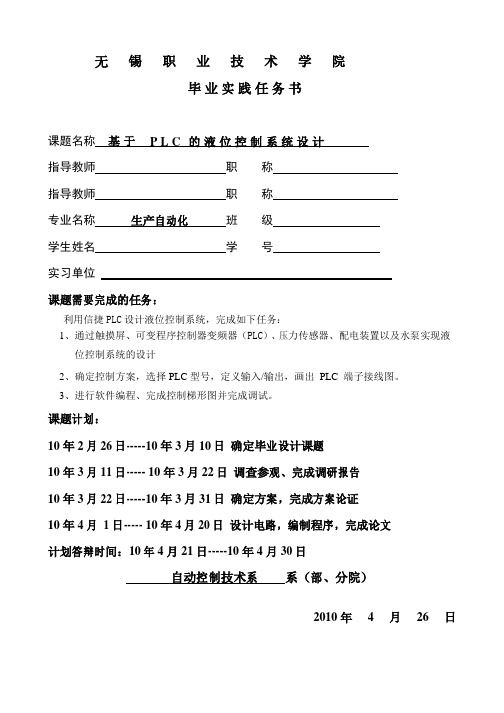
无锡职业技术学院课题名称基于毕业实践任务书P L C 的液位控制系统设计指导教师指导教师专业名称学生姓名生产自动化职职班学称称级号实习单位课题需要完成的任务:利用信捷PLC设计液位控制系统,完成如下任务:1、通过触摸屏、可变程序控制器变频器(PLC)、压力传感器、配电装置以及水泵实现液位控制系统的设计2、确定控制方案,选择PLC型号,定义输入/输出,画出PLC 端子接线图。
3、进行软件编程、完成控制梯形图并完成调试。
课题计划:10 年2月26日-----10年3 月10日确定毕业设计课题10 年3月11日----- 10年3 月22日调查参观、完成调研报告10 年3月22日-----10年3 月31日确定方案,完成方案论证10 年4月1日-----10年4月20日设计电路,编制程序,完成论文计划答辩时间:10年4 月21日-----10年4月30日自动控制技术系系(部、分院)2010 年4月26日PLCs--Past, Present and FutureEveryone knows there's only one constant in the technology world,and that's change. This is especially evident in the evolution of Programmable Logic Controllers (PLC) and their varied applications. From their introduction more than 30 years ago, PLCs have become the cornerstone of hundreds of thousands of control systems in a wide range of industries.At heart,the PLC is an industrialized computer programmed with highly specialized languages, and it continues to benefit from technological advancesin the computer and information technology worlds. The most prominent of whichis miniaturization and communications.The Shrinking PLCWhen the PLC was first introduced, its size was a major improvement - relative to the hundreds of hard-wired relays and timers it replaced.A typical unit housing a CPU and I/O was roughly the size of a19 television set. Through the 1980s and early 1990s, modular PLCs continued to shrink in footprint while increasing in capabilities and performance (see Diagram1for typical modular PLC configuration).In recent years, smaller PLCs have been introduced in the nano and micro classes that offer features previously found only in larger PLCs.This has made specifying a larger PLC just for additional features or performance, and not increased I/O count, unnecessary, as even those in the nano class are capable of Ethernet communication, motion control, on-board PID with autotune, remote connectivity and more.PLCs are also now well-equipped to replace stand-alone process controllersin many applications, due to their ability to perform functions of motion control, data acquisition, RTU (remote telemetry unit) and even some integrated HMI (human machine interface) functions. Previously, these functions often required their own purpose-built controllers and software, plus a separate PLC for the discrete control and interlocking.The Great CommunicatorPossibly the most significant change in recent years lies in the communications arena. In the1970s Modicon introduction of Modbus communications protocol allowed PLCs to communicate over standard cabling. This translates to an ability to place PLCs in closer proximity to real world devices and communicate back to other system controls in a main panel.In the past30 years we have seen literally hundreds of proprietary and standard protocols developed,each with their own unique advantages.Today's PLCs have to be data compilers and information gateways. They have to interface with bar code scanners and printers, as well as temperature and analog sensors. They need multiple protocol support to be able to connect with other devices in the process. And furthermore, they need all these capabilities while remaining cost- effective and simple to program.Another primary development that has literally revolutionized the way PLCs are programmed,communicate with each other and interface with PCs for HMI, SCADA or DCS applications, came from the computing world.Use of Ethernet communications on the plant floor has doubled in the pastfive years. While serial communications remain popular and reliable, Ethernet is fast becoming the communications media of choice with advantages that simplycan't be ignored, such as:* Network speed.* Ease of use when it comes to the setup and wiring. *Availability of off-the-shelf networking components. *Built-in communications setups.Integrated Motion ControlAnother responsibility the PLC has been tasked with is motion control.From simple open-loop to multi-axis applications, the trend has been to integratethis feature into PLC hardware and software.There are many applications that require accurate control at a fast pace, but not exact precision at blazing speeds. These are applications where the stand-alone PLC works well.Many nano and micro PLCs are available with high- speed counting capabilities and high-frequency pulse outputs built into the controller,making them a viable solution for open-loop control.The one caveat is that the controller does not know the position of the output device during the control sequence. On the other hand,its main advantage is cost. Even simple motion control had previously required an expensive option module, and at times was restricted to more sophisticated control platforms in order to meet system requirements.More sophisticated motion applications require higher-precision positioning hardware and software, and many PLCs offer high-speed option modules that interface with servo drives. Most drives today can accept traditional commands from host(PLC or PC) controls, or provide their own internal motion control. The trend here is to integrate the motion control configuration into the logic controller programming software package.Programming LanguagesA facet of the PLC that reflects both the past and the future is programming language.The IEC 61131-3 standard deals with programming languages and definestwo graphical and two textual PLC programming language standards: *Ladder logic (graphical).* Function block diagram (graphical). *Structured text(textual).Instruction list (textual).This standard also defines graphical and textual sequential function chart elements to organize programs for sequential and parallel control processing. Based on the standard, many manufacturers offer at least two of these languagesas options for programming their PLCs. Ironically, approximately 96 percent ofPLC users recently still use ladder diagrams to construct their PLC code. It seems that ladder logic continues to be a top choice given it's performed sowell for so long.Hardware PlatformsThe modern PLC has incorporated many types of Commercial off the Shelf (COTS) technology in its CPU.This latest technology gives the PLC a faster,more powerful processor with more memory at less cost. These advances have alsoallowed the PLC to expand its portfolio and take on new tasks like communications, data manipulation and high-speed motion without giving up the rugged and reliable performance expected from industrial control equipment.New technology has also created a category of controllers calledProgrammable Automation Controllers,or PACs. PACs differ from traditional PLCsin that they typically utilize open, modular architectures for both hardware and software,using de facto standards for network interfaces, languages and protocols.They could be viewed as a PC in an industrial PLC-like package.The FutureA 2005 PLC Product Focus Study from Reed Research Group pointed out factors increasingly important to users, machine builders and those making thepurchasing decisions. The top picks for features of importance were.* The ability to network, and do so easily. Ethernet communications isleading the charge in this realm. Not only are new protocols surfacing, but manyof the industry de facto standard serial protocols that have been used for many years are being ported to Ethernet platforms. These include Modbus (ModbusTCP), DeviceNet(Ethernet/IP) and Profibus(Profinet). Ethernet communication modulesfor PLCs are readily available with high-speed performance and flexibleprotocols.Also,many PLC CPUs are now available with Ethernet ports on board, saving I/O slot space. PLCs will continue to develop more sophisticatedconnectivity to report information to other PLCs,system control systems, dataacquisition(SCADA) systems and enterprise resource planning (ERP) systems. Additionally, wireless communications will continue to gain popularity.* The ability to network PLC I/O connections with a PC. The same trends that have benefited PLC networking have migrated to the I/O level.Many PLC manufacturers are supporting the most accepted fieldbus networks, allowing PLC I/O to be distributed over large physical distances, or located where it was previously considered nearly impossible. This has opened the door for personal computers to interface with standard PLC I/O subsystems by using interface cards, typically supplied by the PLC manufacturer or a third party developer.Now these challenging locations can be monitored with today a PC. Where industrial-grade control engines are not required, the user can take advantage of more advanced software packages and hardware flexibility at a lower cost.* The ability to use universal programming software for multipletargets/platforms.In the past it was expected that an intelligent controller would be complex to program.That is no longer the case. Users are no longerjust trained programmers, such as design engineers or systems integrators, butend-users who expect easier-to-use software in more familiar formats. TheWindows-based look and feel that users are familiar with on their personal computers have become the most accepted graphical user interface. What began as simple relay logic emulation for programming PLCs has evolved into languagesthat use higher level function blocks that are much more intuitive to configure. PLC manufacturers are also beginning to integrate the programming of diverse functions that allow you to learn only one package in configuring logic, HMI, motion control and other specialized capabilities. Possibly the ultimate wish of the end-user would be for a software package that could seamlessly program many manufacturers PLCs and sub-systems. After all, Microsoft Windows operatingsystem and applications work similarly whether installed on a Dell, HP or IBM computer,which makes it easier for the user.Overall, PLC users are satisfied with the products currently available,while keeping their eye on new trends and implementing them where the benefitsare obvious.Typically, new installations take advantage of advancing technologies,helping them become more accepted in the industrial world.PLC的过去、现在与未来众所周知,科技世界里只有一个永恒真理,那就是变化。
- 1、下载文档前请自行甄别文档内容的完整性,平台不提供额外的编辑、内容补充、找答案等附加服务。
- 2、"仅部分预览"的文档,不可在线预览部分如存在完整性等问题,可反馈申请退款(可完整预览的文档不适用该条件!)。
- 3、如文档侵犯您的权益,请联系客服反馈,我们会尽快为您处理(人工客服工作时间:9:00-18:30)。
基于PLC的液位控制系统毕业设计论文摘要:本文基于PLC(可编程逻辑控制器)技术,设计了一种液位控制系统,该系统能够实时监测液位,并根据设定值进行液位控制。
本文详细介绍了该系统的硬件设计、软件设计以及系统测试,并对系统的性能进行了评估和分析。
实验结果表明,该液位控制系统能够稳定可靠地实现对液位的控制。
关键词:PLC;液位控制;硬件设计;软件设计;系统测试
1.引言
液位控制是工业中常见的一种控制过程。
在各种工业领域,如化工、能源、水利等,在液位控制方面都有较高的需求。
随着自动化技术的不断发展,PLC技术成为液位控制的一个重要工具。
2.系统硬件设计
在本系统硬件设计中,我们采用了PLC、液位传感器、电磁阀等关键元件。
PLC作为控制中心,接收传感器的信号,根据设定值来控制电磁阀的开启和关闭。
液位传感器负责实时监测液位的变化,并将信号传输给PLC。
电磁阀根据PLC的指令来控制液位的增减。
3.系统软件设计
在本系统软件设计中,我们使用了PLC编程语言来实现液位控制的逻辑。
首先,我们定义了PLC的输入和输出信号,然后根据设定的逻辑进行编程。
具体来说,当液位高于设定值时,PLC会关闭电磁阀,减少液位的上升;当液位低于设定值时,PLC会打开电磁阀,增加液位的下降。
通过循环执行这些逻辑,系统可以实现对液位的控制。
4.系统测试
为了验证系统的可行性和性能,我们进行了一系列的测试。
首先,我
们针对液位控制器的输入输出进行了测试,确保其正常工作。
然后,我们
使用液位泵和液位计进行了实际测试,记录了系统在不同液位变化条件下
的性能。
实验结果表明,该液位控制系统具有良好的稳定性和可靠性。
5.结果和分析
通过对实验数据的分析,我们得出了以下结论:该液位控制系统能够
满足不同液位变化条件下的控制需求;系统响应速度较快,能够在短时间
内完成液位的调整;系统具有良好的稳定性,能够稳定地维持设定的液位。
6.结论
本文基于PLC技术设计了一种液位控制系统,并进行了详细的硬件设计、软件设计和系统测试。
实验结果表明,该系统具有良好的性能和稳定性,能够有效地实现液位的控制。
该系统在工业生产中有着广泛的应用前景。
